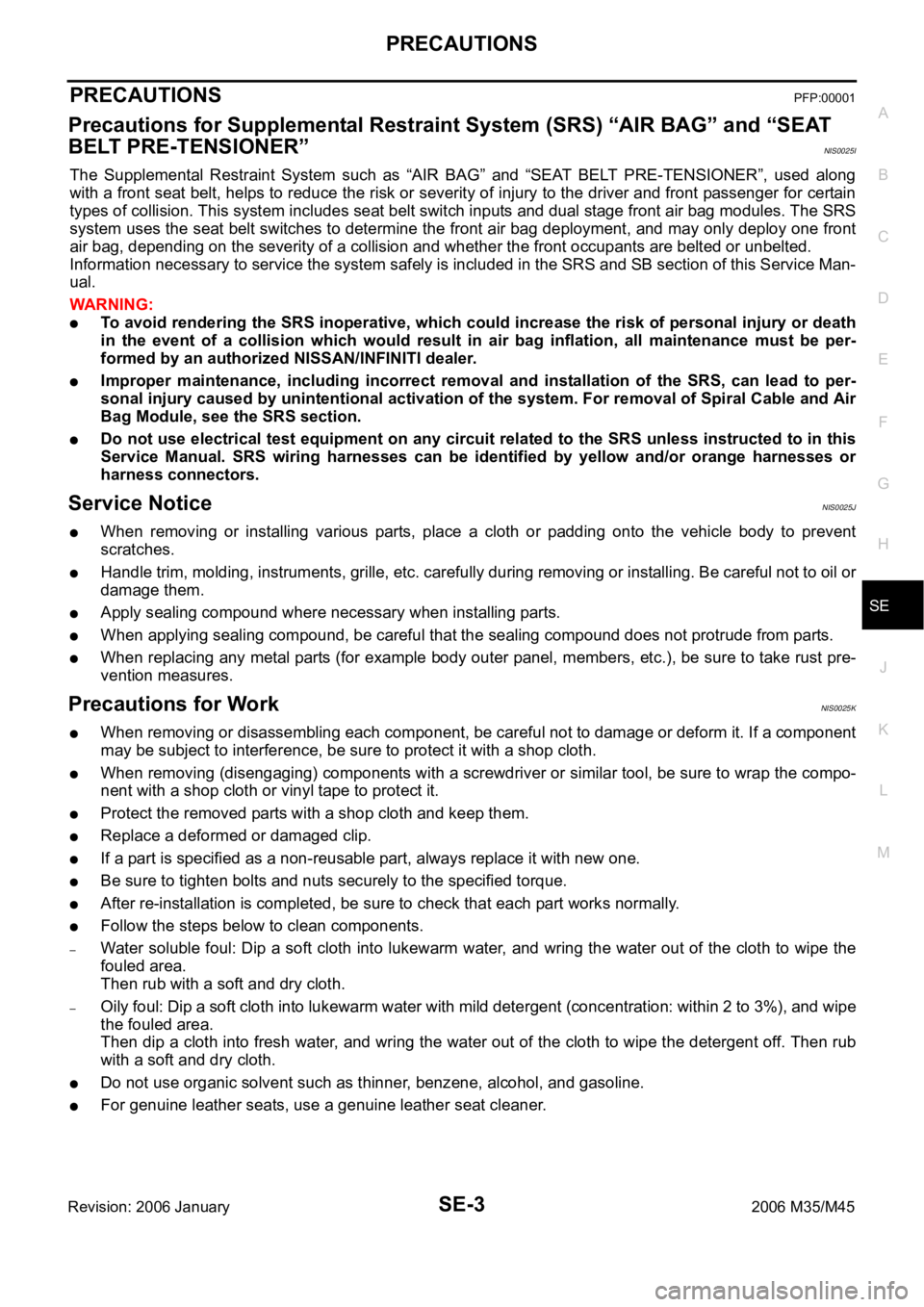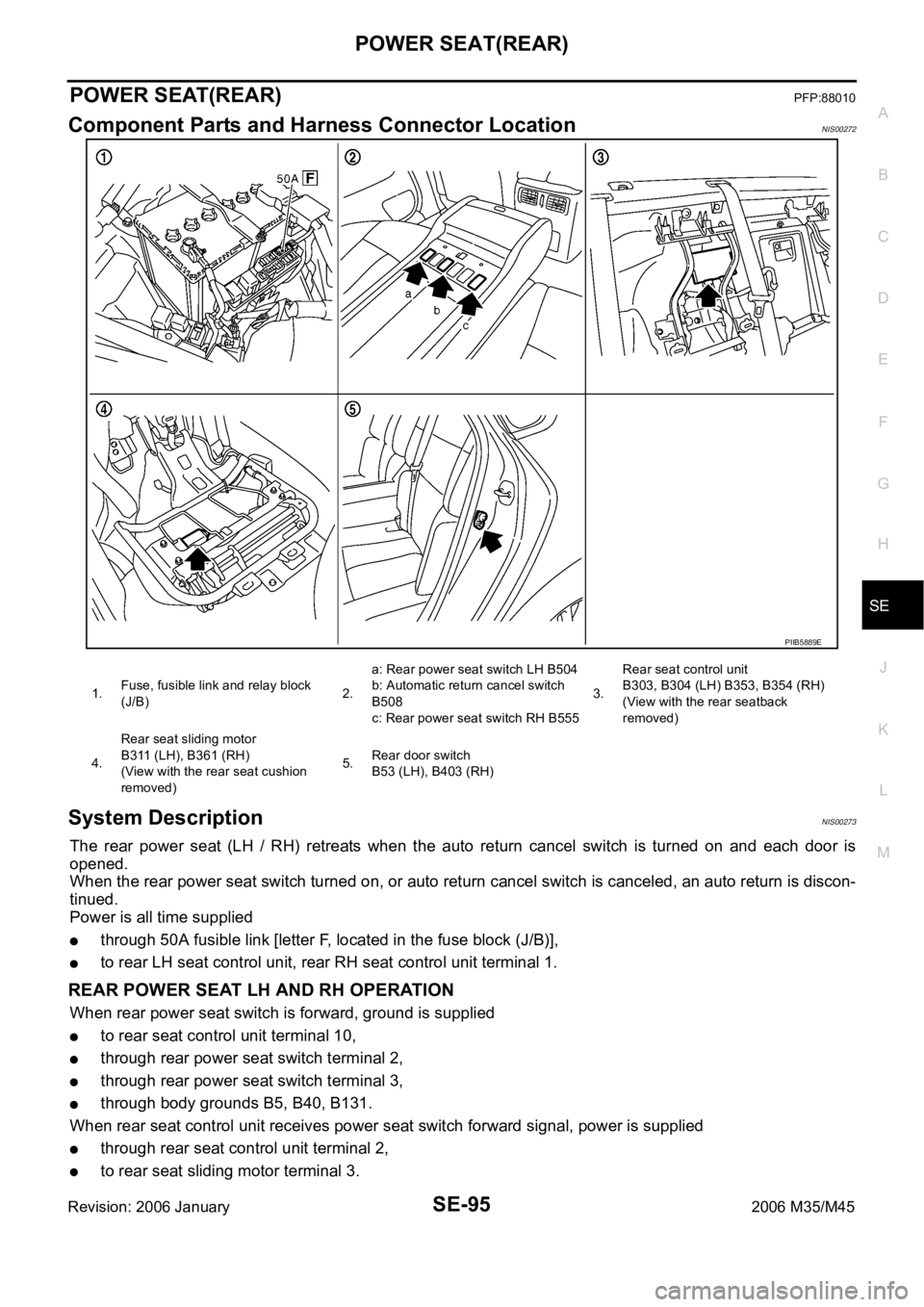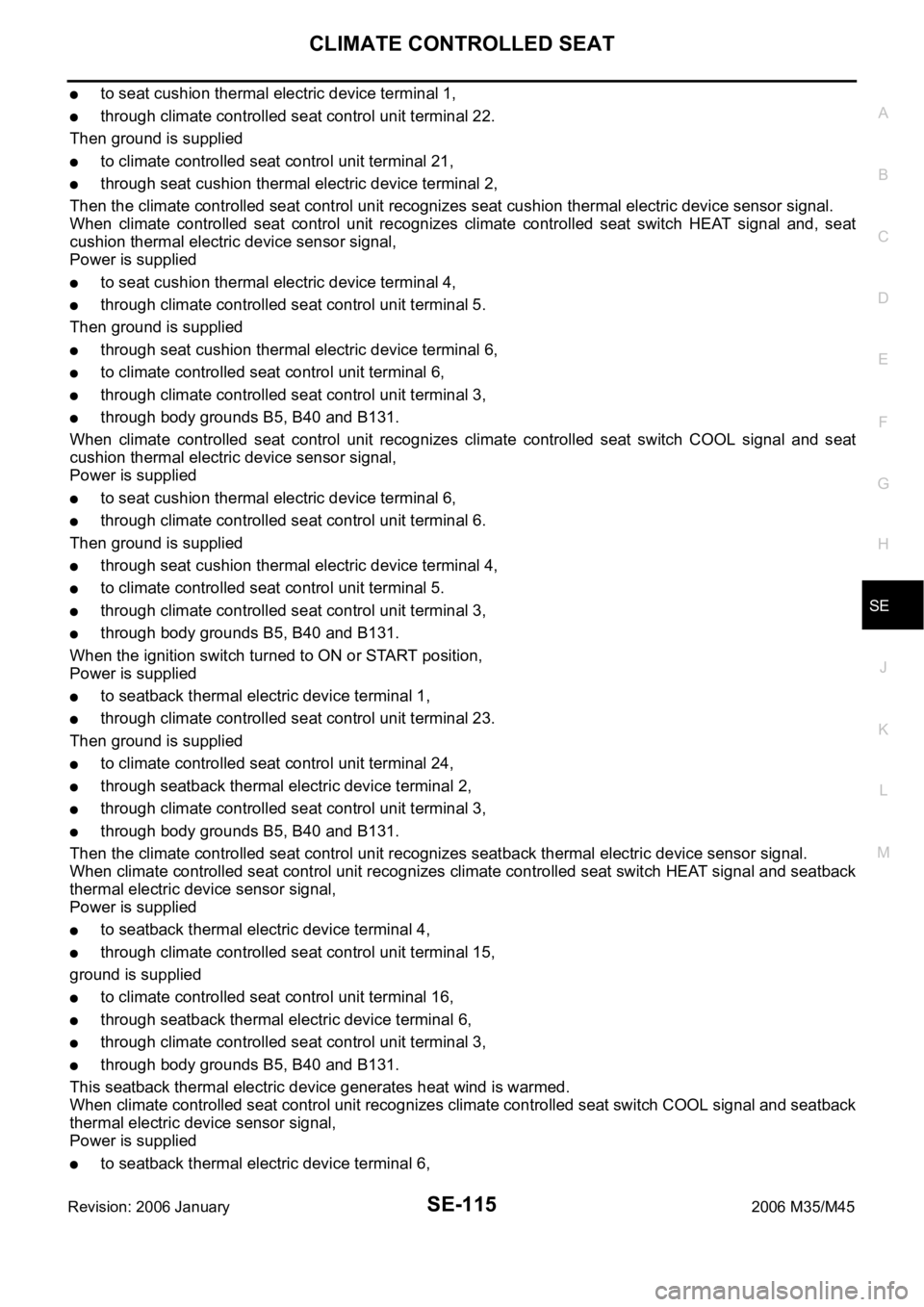2006 INFINITI M35 Body
[x] Cancel search: BodyPage 5131 of 5621

SB-32
SEAT BELTS
Revision: 2006 January2006 M35/M45
Removal and Installation of Rear Seat Belt NHS0008K
REMOVAL OF SEAT BELT RETRACTOR
1. Remove the outer and inner anchors.
Remove the rear seat cushion, refer to SE-176, "Removal and Installation" .
Remove the outer anchor fixing anchor bolt and the anchor bolt tightening the inner anchor together
with the seat belt buckle.
2. Remove the seat belt assembly.
Remove the rear seatback, refer to SE-176, "Removal and Installation" .
Remove the rear kicking plate, the rear wheelhouse garnish and the rear pillar finisher, refer to EI-37,
"BODY SIDE TRIM" .
Remove the seat belt finisher from the rear parcel shelf finisher, refer to EI-42, "REAR PARCEL SHELF
FINISHER" .
Remove the rear parcel shelf finisher, refer to EI-42, "REAR PARCEL SHELF FINISHER" .
Remove the fixing anchor bolt of the seat belt retractor.
INSTALLATION OF SEAT BELT RETRACTOR
Install in the reverse order of removal.
Tighten by specified torque.
REMOVAL OF SEAT BELT BUCKLE
1. Remove the seat belt buckle.
Remove the rear seat cushion, refer to SE-176, "Removal and Installation" .
Remove the fixing anchor bolt of the inner anchor.
1. Outer anchor 2. Inner anchor 3. Center seat belt retractor
4. Outer seat belt retractor 5. Anchor bolt 6. Retractor cover
PHIA1107E
Tightening torque : 49.0 Nꞏm (5.0 kg-m, 36 ft-lb)
Page 5182 of 5621

SE-1
SEAT
I BODY
CONTENTS
C
D
E
F
G
H
J
K
L
M
SECTION SE
A
B
SE
Revision: 2006 January2006 M35/M45
SEAT
PRECAUTIONS .......................................................... 3
Precautions for Supplemental Restraint System
(SRS) “AIR BAG” and “SEAT BELT PRE-TEN-
SIONER” .................................................................. 3
Service Notice .......................................................... 3
Precautions for Work ...........................................
..... 3
PREPARATION ........................................................... 4
Special Service Tools ............................................... 4
Commercial Service Tools ........................................ 4
SQUEAK AND RATTLE TROUBLE DIAGNOSES ..... 5
Work Flow ................................................................ 5
CUSTOMER INTERVIEW ..................................... 5
DUPLICATE THE NOISE AND TEST DRIVE ....... 6
CHECK RELATED SERVICE BULLETINS ........... 6
LOCATE THE NOISE AND IDENTIFY THE
ROOT CAUSE ...................................................... 6
REPAIR THE CAUSE ........................................... 6
CONFIRM THE REPAIR ....................................... 7
Generic Squeak and Rattle Troubleshooting ........... 7
INSTRUMENT PANEL .......................................... 7
CENTER CONSOLE ............................................. 7
DOORS ................................................................. 7
TRUNK .................................................................. 8
SUNROOF/HEADLINING ..................................... 8
SEATS ................................................................... 8
UNDERHOOD ....................................................... 8
Diagnostic Worksheet .............................................. 9
AUTOMATIC DRIVE POSITIONER ...........................11
Component Parts And Harness Connector Location
.... 11
System Description ................................................ 12
MANUAL OPERATION ....................................... 12
MEMORY OPERATION ...................................... 12
EXITING OPERATION ........................................ 14
ENTRY OPERATION .......................................... 14
INTELLIGENT KEY INTERLOCK OPERATION ... 15
FAIL-SAFE MODE .............................................. 15
INITIALIZATION PROCEDURE .......................... 16
SETTING CHANGE FUNCTION ......................... 16
CAN Communication System Description .............. 16CAN Communication Unit ....................................... 16
Schematic ............................................................... 17
Wiring Diagram—AUT/DP— .................................. 19
Terminals and Reference Values for BCM .............. 30
Terminals and Reference Value for Intelligent Key
Unit ......................................................................... 30
Terminals and Reference Values for Driver Seat
Control Unit ............................................................. 31
Terminals and Reference Values for Automatic
Drive Positioner Control Unit .................................. 33
CONSULT-II Function (AUTO DRIVE POS.) .......... 35
CONSULT-II INSPECTION PROCEDURE .......... 35
SELF-DIAGNOSIS RESULTS ............................. 36
DATA MONITOR ................................................. 37
ACTIVE TEST ..................................................... 38
WORK SUPPORT ............................................... 38
Work Flow ............................................................... 39
Symptom Chart ....................................................... 39
CAN Communication Inspection Using CONSULT-
II (Self-Diagnosis) ................................................... 41
BCM Power Supply and Ground Circuit Check ...... 41
Driver Seat Control Unit Power Supply and Ground
Circuit Check .......................................................... 42
Automatic Drive Positioner Power Supply and
Ground Circuit Check ............................................. 43
Sliding Motor Circuit Check .................................... 44
Reclining Motor LH Circuit Check ........................... 45
Front Lifting Motor Circuit Check ............................ 46
Rear Lifting Motor Circuit Check ............................. 48
Telescopic Motor Circuit Check .............................. 49
Tilt Motor Circuit Check .......................................
... 50
Sliding Sensor Circuit Check .................................. 52
Reclining Sensor Circuit Check .............................. 54
Front Lifting Sensor Circuit Check .......................... 56
Rear Lifting Sensor Circuit Check .......................... 58
Telescopic Sensor Circuit Check ............................ 60
Tilt Sensor Circuit Check ........................................ 62
Door Mirror Sensor LH Circuit Check ..................... 63
Door Mirror Sensor RH Circuit Check .................... 66
Sliding Switch Circuit Check ................................... 68
Page 5184 of 5621

PRECAUTIONS
SE-3
C
D
E
F
G
H
J
K
L
MA
B
SE
Revision: 2006 January2006 M35/M45
PRECAUTIONSPFP:00001
Precautions for Supplemental Restraint System (SRS) “AIR BAG” and “SEAT
BELT PRE-TENSIONER”
NIS0025I
The Supplemental Restraint System such as “AIR BAG” and “SEAT BELT PRE-TENSIONER”, used along
with a front seat belt, helps to reduce the risk or severity of injury to the driver and front passenger for certain
types of collision. This system includes seat belt switch inputs and dual stage front air bag modules. The SRS
system uses the seat belt switches to determine the front air bag deployment, and may only deploy one front
air bag, depending on the severity of a collision and whether the front occupants are belted or unbelted.
Information necessary to service the system safely is included in the SRS and SB section of this Service Man-
ual.
WAR NING :
To avoid rendering the SRS inoperative, which could increase the risk of personal injury or death
in the event of a collision which would result in air bag inflation, all maintenance must be per-
formed by an authorized NISSAN/INFINITI dealer.
Improper maintenance, including incorrect removal and installation of the SRS, can lead to per-
sonal injury caused by unintentional activation of the system. For removal of Spiral Cable and Air
Bag Module, see the SRS section.
Do not use electrical test equipment on any circuit related to the SRS unless instructed to in this
Service Manual. SRS wiring harnesses can be identified by yellow and/or orange harnesses or
harness connectors.
Service NoticeNIS0025J
When removing or installing various parts, place a cloth or padding onto the vehicle body to prevent
scratches.
Handle trim, molding, instruments, grille, etc. carefully during removing or installing. Be careful not to oil or
damage them.
Apply sealing compound where necessary when installing parts.
When applying sealing compound, be careful that the sealing compound does not protrude from parts.
When replacing any metal parts (for example body outer panel, members, etc.), be sure to take rust pre-
vention measures.
Precautions for WorkNIS0025K
When removing or disassembling each component, be careful not to damage or deform it. If a component
may be subject to interference, be sure to protect it with a shop cloth.
When removing (disengaging) components with a screwdriver or similar tool, be sure to wrap the compo-
nent with a shop cloth or vinyl tape to protect it.
Protect the removed parts with a shop cloth and keep them.
Replace a deformed or damaged clip.
If a part is specified as a non-reusable part, always replace it with new one.
Be sure to tighten bolts and nuts securely to the specified torque.
After re-installation is completed, be sure to check that each part works normally.
Follow the steps below to clean components.
–Water soluble foul: Dip a soft cloth into lukewarm water, and wring the water out of the cloth to wipe the
fouled area.
Then rub with a soft and dry cloth.
–Oily foul: Dip a soft cloth into lukewarm water with mild detergent (concentration: within 2 to 3%), and wipe
the fouled area.
Then dip a cloth into fresh water, and wring the water out of the cloth to wipe the detergent off. Then rub
with a soft and dry cloth.
Do not use organic solvent such as thinner, benzene, alcohol, and gasoline.
For genuine leather seats, use a genuine leather seat cleaner.
Page 5187 of 5621

SE-6
SQUEAK AND RATTLE TROUBLE DIAGNOSES
Revision: 2006 January2006 M35/M45
DUPLICATE THE NOISE AND TEST DRIVE
If possible, drive the vehicle with the customer until the noise is duplicated. Note any additional information on
the Diagnostic Worksheet regarding the conditions or location of the noise. This information can be used to
duplicate the same conditions when you confirm the repair.
If the noise can be duplicated easily during the test drive, to help identify the source of the noise, try to dupli-
cate the noise with the vehicle stopped by doing one or all of the following:
1) Close a door.
2) Tap or push/pull around the area where the noise appears to be coming from.
3) Rev the engine.
4) Use a floor jack to recreate vehicle “twist”.
5) At idle, apply engine load (electrical load, half-clutch on M/T models, drive position on A/T models).
6) Raise the vehicle on a hoist and hit a tire with a rubber hammer.
Drive the vehicle and attempt to duplicate the conditions the customer states exist when the noise occurs.
If it is difficult to duplicate the noise, drive the vehicle slowly on an undulating or rough road to stress the
vehicle body.
CHECK RELATED SERVICE BULLETINS
After verifying the customer concern or symptom, check ASIST for Technical Service Bulletins (TSBs) related
to that concern or symptom.
If a TSB relates to the symptom, follow the procedure to repair the noise.
LOCATE THE NOISE AND IDENTIFY THE ROOT CAUSE
1. Narrow down the noise to a general area. To help pinpoint the source of the noise, use a listening tool
(Chassis Ear: J-39570, Engine Ear and mechanics stethoscope).
2. Narrow down the noise to a more specific area and identify the cause of the noise by:
removing the components in the area that you suspect the noise is coming from.
Do not use too much force when removing clips and fasteners, otherwise clips and fastener can be broken
or lost during the repair, resulting in the creation of new noise.
tapping or pushing/pulling the component that you suspect is causing the noise.
Do not tap or push/pull the component with excessive force, otherwise the noise will be eliminated only
temporarily.
feeling for a vibration with your hand by touching the component(s) that you suspect is (are) causing the
noise.
placing a piece of paper between components that you suspect are causing the noise.
looking for loose components and contact marks.
Refer to SE-7, "
Generic Squeak and Rattle Troubleshooting" .
REPAIR THE CAUSE
If the cause is a loose component, tighten the component securely.
If the cause is insufficient clearance between components:
–separate components by repositioning or loosening and retightening the component, if possible.
–insulate components with a suitable insulator such as urethane pads, foam blocks, felt cloth tape or ure-
thane tape. A Nissan Squeak and Rattle Kit (J-43980) is available through your authorized Nissan Parts
Department.
CAUTION:
Do not use excessive force as many components are constructed of plastic and may be damaged.
NOTE:
Always check with the Parts Department for the latest parts information.
The following materials are contained in the Nissan Squeak and Rattle Kit (J-43980). Each item can be
ordered separately as needed.
URETHANE PADS [1.5 mm (0.059 in) thick]
Insulates connectors, harness, etc.
76268-9E005: 100
135 mm (3.945.31 in)/76884-71L01: 6085 mm (2.363.35 in)/76884-
71L02: 15
25 mm (0.590.98 in)
INSULATOR (Foam blocks)
Insulates components from contact. Can be used to fill space behind a panel.
73982-9E000: 45 mm (1.77 in) thick, 50
50 mm (1.971.97 in)/73982-50Y00:
10 mm (0.39 in) thick, 50
50 mm (1.971.97 in)
Page 5276 of 5621

POWER SEAT(REAR)
SE-95
C
D
E
F
G
H
J
K
L
MA
B
SE
Revision: 2006 January2006 M35/M45
POWER SEAT(REAR)PFP:88010
Component Parts and Harness Connector LocationNIS00272
System DescriptionNIS00273
The rear power seat (LH / RH) retreats when the auto return cancel switch is turned on and each door is
opened.
When the rear power seat switch turned on, or auto return cancel switch is canceled, an auto return is discon-
tinued.
Power is all time supplied
through 50A fusible link [letter F, located in the fuse block (J/B)],
to rear LH seat control unit, rear RH seat control unit terminal 1.
REAR POWER SEAT LH AND RH OPERATION
When rear power seat switch is forward, ground is supplied
to rear seat control unit terminal 10,
through rear power seat switch terminal 2,
through rear power seat switch terminal 3,
through body grounds B5, B40, B131.
When rear seat control unit receives power seat switch forward signal, power is supplied
through rear seat control unit terminal 2,
to rear seat sliding motor terminal 3.
PIIB5889E
1.Fuse, fusible link and relay block
(J/B)2.a: Rear power seat switch LH B504
b: Automatic return cancel switch
B508
c: Rear power seat switch RH B5553.Rear seat control unit
B303, B304 (LH) B353, B354 (RH)
(View with the rear seatback
removed)
4.Rear seat sliding motor
B311 (LH), B361 (RH)
(View with the rear seat cushion
removed)5.Rear door switch
B53 (LH), B403 (RH)
Page 5277 of 5621

SE-96
POWER SEAT(REAR)
Revision: 2006 January2006 M35/M45
Then ground is supplied
through rear seat sliding motor terminals 5,
through body grounds B5, B40, B131.
When power and ground are supplied, rear power seat slide moves forward.
When rear power seat switch is backward, ground is supplied
to rear seat control unit terminal 15,
through rear power seat switch terminal 1,
through rear power seat switch terminal 3,
through body grounds B5, B40, B131.
When rear seat control unit receives power seat switch backward signal, power is supplied
to rear seat control unit terminal 7,
through rear seat sliding motor terminal 4.
Then ground is supplied
through rear seat sliding motor terminals 5,
through body grounds B5, B40, B131.
When power and ground are supplied, rear power seat slide moves backward.
REAR SEAT RETREAT FUNCTION
When rear door open, ground is supplied
to rear seat control unit terminal 16,
through rear door switch terminal 2,
When rear seat control unit receives automatic return cancel switch ON and rear door switch open signal,
power is supplied
through rear seat control unit terminal 7,
to rear seat sliding motor terminal 4.
Then ground is supplied
through rear seat sliding motor terminals 5,
through body grounds B5, B40, B131.
When power and ground are supplied, rear power seat slide moves backward.
When rear seat sliding motor is operated, ground is supplied
to rear seat control unit terminal 12,
through rear seat sliding motor terminal 1,
through rear seat sliding motor terminal 2,
through rear seat control unit terminal 19,
through rear seat control unit terminals 13,
through body grounds B5, B40, B131.
Then rear seat control unit receives rear power seat sliding sensor signal.
The rear power seat control unit controls the seat position of the system operation with the signal.
Page 5295 of 5621

SE-114
CLIMATE CONTROLLED SEAT
Revision: 2006 January2006 M35/M45
At the time of work, please turn OFF a switch, and carry it out after checking that the thermal elec-
tric device has got cold.
Power is at all times supplied
through 15A fuse [No. 41 located in the fuse fusible link and relay unit]
to climate controlled seat relay terminals 5.
through 15A fuse [No. 42 located in the fuse fusible link and relay unit]
to climate controlled seat relay terminals 7.
When the ignition switch turned to ON or START position,
Power is supplied
through 10A fuse [No. 12, located in the fuse block (J/B)]
to climate controlled seat relay terminal 2.
Then ground is supplied
to climate controlled seat relay terminal 1,
through body grounds E22 and E43.
Then climate controlled seat relay is energized.
When climate controlled seat relay is turned to ON,
Power is supplied,
through climate controlled seat relay terminal 3,
to climate controlled seat control unit (passenger side) terminal 2 and 4.
through climate controlled seat relay terminal 6,
to climate controlled seat control unit (driver side) terminal 2 and 4.
When climate controlled switch select HEAT, ground is supplied
through climate controlled seat switch terminal 1 and 3,
to climate controlled seat control unit terminal 10.
Then, the climate controlled seat control unit receives climate controlled seat switch HEAT signal.
When climate controlled seat switch select COOL, ground is supplied
through climate controlled seat switch terminal 1 and 2,
to climate controlled seat control unit terminal 20,
Then, the climate controlled seat control unit receives climate controlled switch COOL signal.
When blower motor rotates, signal is transmitted
to climate controlled seat control unit terminal 18,
through climate controlled seat blower motor terminal 1.
This is climate controlled seat blower motor tachometer signal.
When climate controlled seat control unit receives climate controlled seat switch signal and tachometer signal,
Power is supplied
to climate controlled seat blower motor terminal 4,
through climate controlled seat control unit terminal 17.
This is blower motor revolution control signal.
When blower motor receivers blower motor revolution control signal,
Power is supplied
through climate controlled seat control unit terminal 14,
to climate controlled seat blower motor terminal 2.
When number of rotations correspond signal,
Ground is supplied
to climate controlled seat blower motor terminal 3,
through climate controlled seat control unit terminal 7,
through climate controlled seat control unit terminal 3,
through body grounds B5, B40 and B131.
Then motor revolution is controlled.
When the ignition switch turned to ON or START position,
Power is supplied
Page 5296 of 5621

CLIMATE CONTROLLED SEAT
SE-115
C
D
E
F
G
H
J
K
L
MA
B
SE
Revision: 2006 January2006 M35/M45
to seat cushion thermal electric device terminal 1,
through climate controlled seat control unit terminal 22.
Then ground is supplied
to climate controlled seat control unit terminal 21,
through seat cushion thermal electric device terminal 2,
Then the climate controlled seat control unit recognizes seat cushion thermal electric device sensor signal.
When climate controlled seat control unit recognizes climate controlled seat switch HEAT signal and, seat
cushion thermal electric device sensor signal,
Power is supplied
to seat cushion thermal electric device terminal 4,
through climate controlled seat control unit terminal 5.
Then ground is supplied
through seat cushion thermal electric device terminal 6,
to climate controlled seat control unit terminal 6,
through climate controlled seat control unit terminal 3,
through body grounds B5, B40 and B131.
When climate controlled seat control unit recognizes climate controlled seat switch COOL signal and seat
cushion thermal electric device sensor signal,
Power is supplied
to seat cushion thermal electric device terminal 6,
through climate controlled seat control unit terminal 6.
Then ground is supplied
through seat cushion thermal electric device terminal 4,
to climate controlled seat control unit terminal 5.
through climate controlled seat control unit terminal 3,
through body grounds B5, B40 and B131.
When the ignition switch turned to ON or START position,
Power is supplied
to seatback thermal electric device terminal 1,
through climate controlled seat control unit terminal 23.
Then ground is supplied
to climate controlled seat control unit terminal 24,
through seatback thermal electric device terminal 2,
through climate controlled seat control unit terminal 3,
through body grounds B5, B40 and B131.
Then the climate controlled seat control unit recognizes seatback thermal electric device sensor signal.
When climate controlled seat control unit recognizes climate controlled seat switch HEAT signal and seatback
thermal electric device sensor signal,
Power is supplied
to seatback thermal electric device terminal 4,
through climate controlled seat control unit terminal 15,
ground is supplied
to climate controlled seat control unit terminal 16,
through seatback thermal electric device terminal 6,
through climate controlled seat control unit terminal 3,
through body grounds B5, B40 and B131.
This seatback thermal electric device generates heat wind is warmed.
When climate controlled seat control unit recognizes climate controlled seat switch COOL signal and seatback
thermal electric device sensor signal,
Power is supplied
to seatback thermal electric device terminal 6,